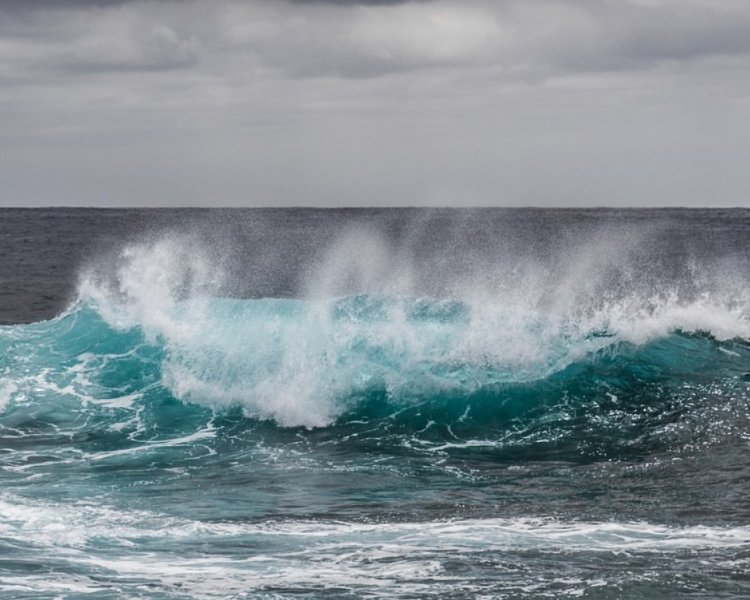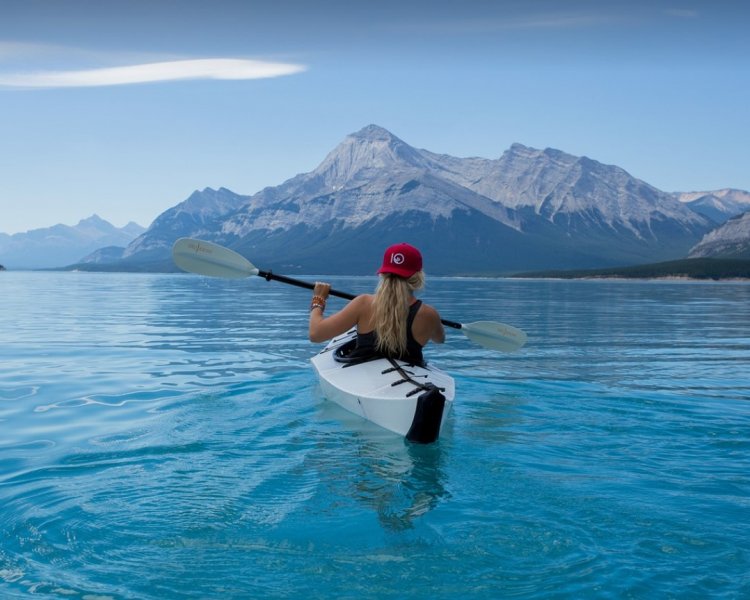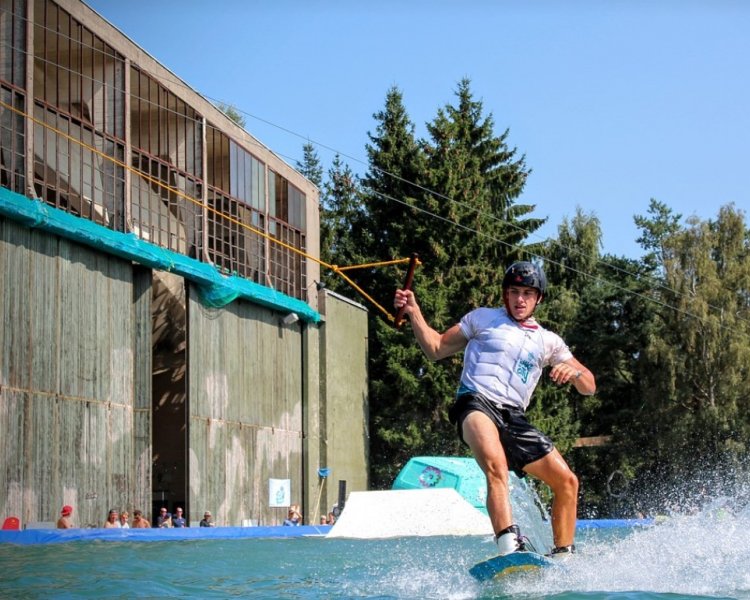What Is Wakeboarding? » The Definitve Guide To Wakeboarding!

If you’re interested in taking up a new and exciting watersport, you might consider wakeboarding. Wakeboarding is one of those action-packed water sports that will leave you breathless, both out of adrenaline and laughter.
Before diving into the sport, though, you need to know everything you can about it.
What is wakeboarding? Wakeboarding is essentially a combination of three sports: surfing, water skiing, and snowboarding. The rider is fastened to a specific wakeboarding board and towed behind a boat. Speeds can reach as high as 30 miles per hour, so plenty of practice and a steady fitness level is encouraged.
If you’re reading to take your chance at wakeboarding, then you need to know all the ins and outs of the sport.
We are going to discuss the different types of equipment needed for wakeboarding, what fitness level is required, the benefits of wakeboarding, and how to get started.
Read Also: Is Wakeboarding Dangerous?
What Is Wakeboarding?
The simplest way to describe wakeboarding is it is the perfect combination of three popular sports:
- Water skiing because the wakeboarder will essentially be skiing across the water, but using one board instead of two.
- Surfing because the rider will be able to ‘ride the waves’ on a single board, although they will be towed by a boat and have a rope to hold onto.
- And finally, snowboarding, as the rider is using a single board to maneuver swiftly across the water, much like someone would on snow.
With a combination like that, it’s no wonder that the original name for wakeboarding was actually ‘skurfing.’ It didn’t stick, though.
There are some unique and distinct differences to wakeboarding, though, which makes it all the more exciting to give it a shot.
The biggest factor that sets wakeboarding apart from other sports is the fact that the rider will be gliding across the water on a single board that is fastened to a boat.
Depending on the speed of the boat, you could land anywhere from 5 miles per hour to over 30.
Another great thing about wakeboarding is the more you practice and become accustomed to the water sport. The rider can start doing tricks on the board behind the boat. This intensifies the entire experience and is pretty fun to watch, too. Just remember that tricks should be left to those completely comfortable with plenty of experience.
The History of Wakeboarding
While there is some speculation on when and where wakeboarding actually began, most of the accepted theories have roots that date back to as young as 1980.
During this time, two men decided to create their own versions of wakeboarding, both of which are used today.
The first theory comes out of Australia in the 1980s from a man named Jeff Darby who referred to his new water activity as skurfing.
Darby and friends made up their own style of boards known as skurfing boards, which were uniquely designed to be pulled behind boats. The new water sport and accompanying boards took off, and they began a company known as ‘Skurfer.’
All while this was happening in Australia, another man was making his way towards wakeboarding in the 1980s. This man is Howard Jacobs, a surfer from Florida. He, too, began making boards specifically designed for being towed behind boats, but his design was slightly different.
The Birth of the Wakeboard
You see, at this moment in time, Australia had a board for ‘skurfing’ that was simply that: a unique, handcrafted board that is great for towing. Well, Howard Jacobs took it one step further by making his handcrafted boards designed with foot straps and pads.
This allowed for greater control while being towed, while also allowing for incredible tricks that simply wouldn’t be possible on a regular board.
From this moment on, wakeboarding became one of the most popular and exciting sports that can be done on the water. It gained so much enthusiasm in the 1980s that it was officially added as a competitive sport in the X Games, with the first arrival seen in the X Games II.
Equipment Used for Wakeboarding
You can't go wakeboarding without the right equipment; that’s a recipe for disaster. A lot of the time, you can make it easier by simply locating a nearby rental center by the lake or ocean that has equipment available for rent.
These centers will have everything you need to start wakeboarding immediately.
Looking to invest in your own equipment instead? Perhaps you’re looking to become the next wakeboarding champion of the world, or you just want to have an incredible time quite often.
We made a complete guide on the equipment needed in case you need some help with it. Take a look by clicking here.
You will need the following equipment:
- Boat. Wakeboarding does not exist without a boat. The type of boat you decide to pair with your board and wakeboarding activities will have a direct impact on your activity. Keep in mind that boats are rather expensive, and this will likely be the last piece of equipment on your list to buy. Renting is a great option.
- Board. Your board will also make or break your wakeboarding adventure. You should always find a quality wakeboard that has excellent quality fins for maneuvering with continuous rockers for the best results. Beginners should take extra time to ensure they are purchasing a boat that has a double-end, as they are far more stable than other models.
- Bindings. When it comes to wakeboards, you have options on your bindings. The available designs include velcro, adjustable boot, and high back boot.
Velcro bindings are best for beginners as they are extremely easy to adjust and provide the right amount of stability.
Adjustable boot bindings allow for a little bit more support.
High back boot bindings have the best level of support but are mostly reserved for those who are performing tricks on the water and need the utmost protection and binding.
- Rope. Keep in mind that the shorter the rope is, the better control you will have while wakeboarding. If you’re a thrill-seeker trying to do tricks, you might find a longer rope that stretches to be the best option. Beginners should opt for shorter length ropes that do not offer any stretching.
- Wetsuit. A wetsuit is another important thing to purchase when you’re planning on wakeboarding. The thickness you decide to buy will be based on where you’re wakeboarding. The cold ocean may require more thickness for comfort, while a lake in the countryside is warm enough for a thinner style wetsuit.
- Buoyancy aid. A lot of people think that buoyancy aids are the same as life jackets, but they aren’t one and the same. Life jackets are reserved for keeping someone afloat when they come off their boat or board, while a buoyancy aid allows for proper swimming when you’re in the water. Choose a buoyancy aid over a life jacket to allow for better swimming to get back to your wakeboard.
Always remember that you do not need to have all of this equipment right off the back. You might want to start off with a board or wetsuit and rent the rest of the equipment, and that is perfectly fine.
You should always make sure you enjoy the art of wakeboarding before spending large amounts of money on all the necessary equipment.
What Fitness Level is Required to Wakeboard?
If you have never tried wakeboarding before, it may look like one of the toughest challenges on the water. Trying to keep yourself on the board while you’re drifting through water pulled by a boat is just as difficult as it sounds; but clearly not impossible.
Starting out maybe a little tricky and require some patience and dedication to get the hang of it. That being said, you don’t actually need any background to wakeboard. However, someone who has a strong set of arms and a good level of fitness may find it a lot easier to stay on top of the board.
Regardless of your fitness level, anyone who tries their hand at wakeboarding should know it’s anything but easy. Wakeboarding requires an ample amount of strength and balance in order to stay on the board, so having strong core muscles may also be beneficial to the new wakeboarder.
What are the Benefits of Wakeboarding?
A lot of people will wakeboard for the simple fact that it is fun and thrilling, and can be done by people of all fitness levels. That being said, there’s a lot of people who are looking for fun new ways to exercise and might wonder is wakeboarding provides any health or fitness benefits.
It comes as no surprise that wakeboarding actually does have quite a few nutritional and fitness benefits, including the following:
- Wakeboarding strengthens the arms and legs. Think about it: your legs have to remain balanced on the board, while your arms have to be able to hold you up and maneuver through the water. That’s a whole lot of pressure on those key muscles, making it a great (and exciting) fitness routine.
- Improves the overall flexibility in hands and feet. When your wakeboarding, your hands and feet will need to remain nimble. With all of this quick and light movement, your hands and feet are going to become more flexible over time.
- It can improve a person’s reaction times. When you’re speeding across the ocean pulled by a boat, of course, you’re going to be alert and reacting quickly. By wakeboarding often, you can improve your overall reaction time on and off the water.
- Improves hand-eye coordination as well as balance. You can’t wakeboard without balance, and hand-eye coordination is key to success. Combining the two, wakeboarding will allow you to improve on your hand-eye coordination skills as well as balancing skills.
- Hone your swimming skills. You’re going to fall when you just start wakeboarding, and probably even when you’re an advanced wakeboarder. That being said, all that time in the water is going to have a positive impact on your swimming ability.
- Improves overall concentration. While wakeboarding you need to concentrate on what you’re doing, or you will end up falling off your board. Wakeboarding regularly can improve your concentration levels both on and off the water.
As you can see, wakeboarding takes quite a toll on your body- in a good way! Whether it’s strengthening up your arms and legs or improving your balancing and concentration skills, wakeboarding is loaded with health and fitness benefits that any wakeboarder will be happy about.
Getting Started with Wakeboarding
If you’re really serious about trying out wakeboarding, there are a few beginner things you need to know before you hop out into the water. Here are some of the best beginner wakeboarding tips for a (somewhat) successful ride on your first time:
- Get a beginner board. There are several beginner models on the market (or for rent). Never choose a pro-board as these are not designed to offer security and balance. Instead, find a beginner’s model that is larger and has multiple rear fins to help with direction and overall balance.
- Choose a short rope. A shorter rope that doesn’t have any ‘give’ to it will offer more control and balance.
- Don’t forget the buoyancy aid. These are imperative, especially if you’re not a top-notch swimmer. Buoyancy aids will keep you afloat while allowing you to swim back to your board with ease, but they will also keep you warm when you’re gliding through the water.
- Get the right footing. This is best done by a professional wakeboard instructor, but really anyone can do it. If you have never gone snowboarding or skateboarding before, you need to find your ‘leading foot’ which is either regular (left foot forward) or goofy (the right foot is forward). Determining your footing is easy: the instructor will push you lightly forward, and whichever foot you land on is your leading foot.
- Figure out the right binding angle. Everyone will have a binding angle that is right for them. The best way to discover what your binding angle is is to discuss with the professional wakeboarding instructor. He will be able to determine how the angulation should be for the best results.
- Learn the hand signals. These are imperative for your safety and go as followed:
| Signal | Translation |
| Thumbs up | Speed up |
| Thumbs down | Slow down |
| Thumb is either up or down with pointer and thumb pinched together. | Speed up or down a little bit. |
| OK sign | Happy with the speed. |
| Karate chop the hand in a new direction. | Move the boat direction. |
| Karate chop the hand in the current direction. | Get the boat straight. |
| Karate chop the hand on your other arm. | Drive at a90-degree angle. |
| Pretend to smash something on your head. | I’m done wakeboarding. |
| Wave after falling if ok. | You’re okay. |
| Form an X over your head if not ok. | I’m ok. Send help. |
Conclusion
Wakeboarding is one of the most thrilling water sports and provides tons of laughter and good times.
It’s the perfect combination of skiing, surfing, and snowboarding, making it the go-to sport for many thrillseekers.
Keep in mind that the right equipment should be used at all times and make sure you understand hand signals and footing before trying to wakeboard.
We made a complete guide on the equipment needed in case you need some help with it. Take a look by clicking here.
...
Til slut vil vi hurtigt takke avxperten for have støttet muligheden for at udarbejde, teksten på netop denne artikel. Her finder du et imponerende sortiment af havebelysning, eller utallige andre gode varer. Herfra siger vi tusind tak.



